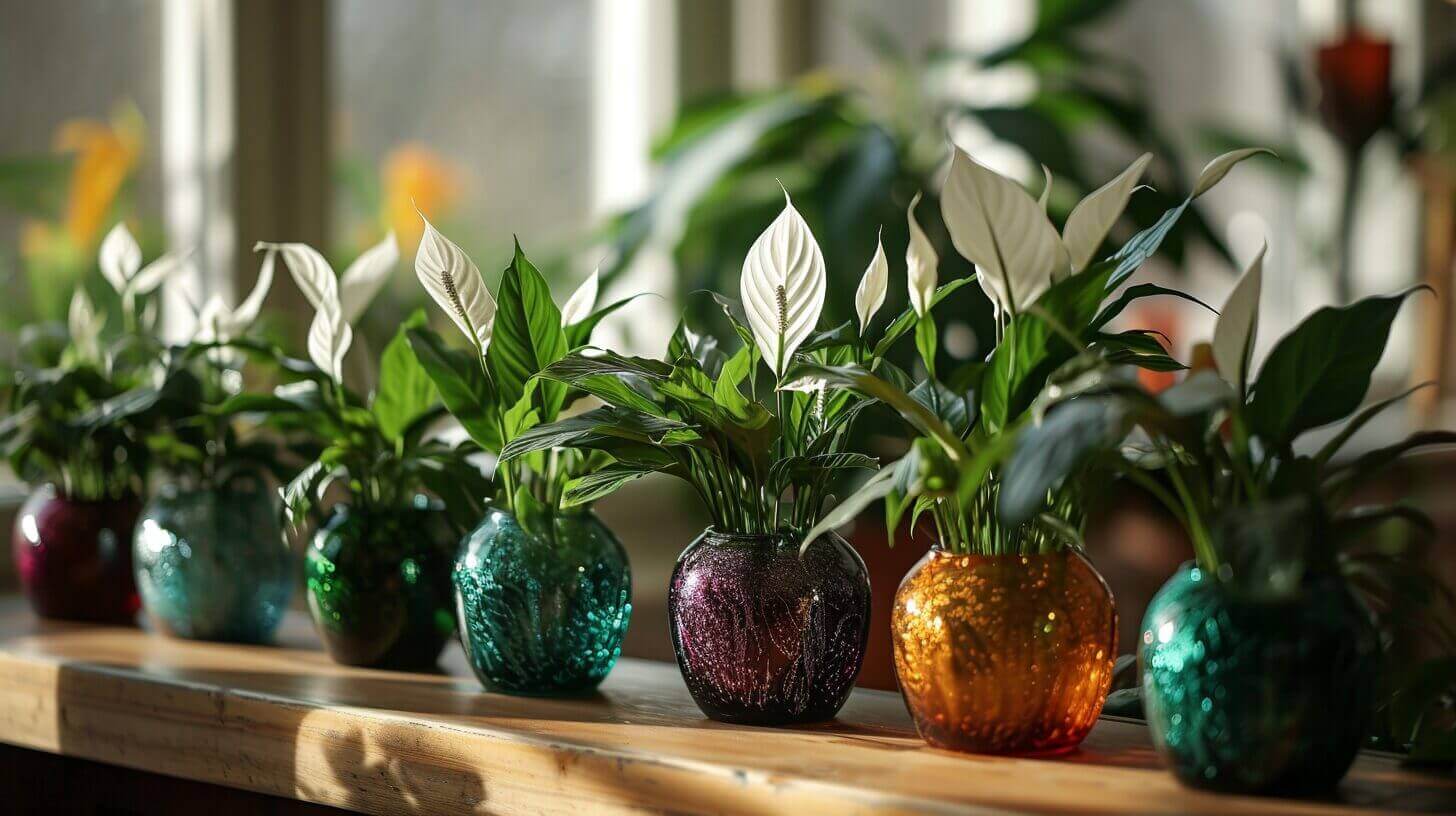How to Get a Peace Lily to Bloom: Tips to Get Peace Lily Flowering Indoors
Discover the secrets to successfully coaxing your peace lily indoor plant into full bloom with our expert tips.
This comprehensive guide provides detailed instructions on how to trigger flowering by understanding the plant’s blooming cycle, optimizing lighting conditions, maintaining ideal temperature and humidity levels, implementing proper watering techniques, and enhancing blooming potential through fertilization and pruning.
Whether you’re a novice or experienced gardener, our informative and organized approach will help you create an environment where your peace lily can thrive and flourish, bringing a sense of belonging to your indoor space.
Key Takeaways
- Pruning techniques can help maintain the size and shape of the Peace Lily and encourage new blooms.
- Providing the right lighting conditions, such as placing the plant near a north or east-facing window, is important for triggering flowering.
- Maintaining optimal temperature and humidity levels is crucial for the growth and blooming of Peace Lilies.
- Consistent and careful watering, avoiding both overwatering and underwatering, is essential for the optimal growth and health of the plant.
Understanding the Peace Lilies Flower Cycle
Understanding the Peace Lily’s blooming cycle is essential for successfully triggering flowering, as it allows us to determine the optimal frequency of care and environmental conditions required for consistent blossoming. One important aspect of the blooming cycle is pruning techniques. Pruning not only helps maintain the plant’s size and shape but also encourages the development of new blooms. To prune a Peace Lily, simply remove any dead or yellowing leaves or flowers, making sure to cut them near the base of the plant. This helps redirect the plant’s energy towards producing new blooms.
Another crucial factor in understanding the Peace Lily’s blooming cycle is understanding the triggers for blooming. Peace Lilies thrive in warm and humid environments, so keeping the temperature around 65-85°F (18-29°C) and humidity levels between 40-60% is ideal. Additionally, providing the right lighting conditions is vital. Peace Lilies prefer bright, indirect light, so placing them near a north or east-facing window is perfect. Avoid placing them in direct sunlight as it can scorch their leaves.
By understanding the Peace Lily’s blooming cycle, implementing proper pruning techniques, and providing the right lighting conditions, you can create an environment that encourages consistent blooming.
In the next section, we will explore the importance of providing adequate watering and fertilization to further enhance the flowering process.
Get Peace Lily Plant To Bloom Wiht The Right Lighting Conditions
To ensure optimal blooming, it is crucial to provide the Peace Lily with the appropriate lighting conditions, such as bright, indirect light near a north or east-facing window. Indoor gardening enthusiasts know that natural light plays a vital role in the growth and development of plants. The Peace Lily, scientifically known as Spathiphyllum, is no exception to this rule.
Peace Lilies are native to the tropical rainforests of Central and South America, where they thrive under the dappled shade of the canopy. Mimicking these conditions indoors is essential for triggering their flowering process. Placing the plant near a north or east-facing window provides the ideal balance of bright, indirect light that the Peace Lily requires.
Direct sunlight can scorch the delicate leaves of the Peace Lily, so it is best to avoid placing it in direct sunlight. However, too little light can also hinder flower production. If a suitable window location is not available, you can supplement with artificial lighting, such as fluorescent or LED grow lights, positioned about 12 to 18 inches above the plant.
Remember to monitor the light levels and adjust accordingly as the seasons change. With proper lighting conditions, your Peace Lily will reward you with its beautiful white flowers, creating a serene and harmonious atmosphere in your indoor garden.
Give Your Peace Lily the Perfect Temperature and Humidity Levels
Maintaining ideal temperature and humidity levels is crucial for the optimal growth and blooming of the Peace Lily. This tropical plant thrives in warm and humid conditions, mimicking its natural habitat. Here are some tips to ensure you provide the perfect environment for your Peace Lily:
- Ideal temperature: The Peace Lily prefers temperatures between 65-85°F (18-29°C). Avoid exposing it to sudden temperature changes or drafts, as they can stress the plant and hinder its flowering.
- Humidity levels: Peace Lilies thrive in high humidity environments. Aim for a relative humidity level of 40-60%. You can increase humidity by placing the plant on a tray filled with water and pebbles or by using a humidifier nearby.
- Misting: Regularly misting the leaves of your Peace Lily can help increase humidity and prevent the leaves from drying out. Use room temperature water and mist in the morning to allow the leaves to dry before nightfall.
By maintaining these optimal environmental conditions, you can encourage your Peace Lily to bloom. Remember to monitor the temperature and humidity levels regularly and make adjustments as necessary.
Providing a comfortable and suitable environment will ensure that your Peace Lily thrives and rewards you with beautiful blooms.
Nurturing With Proper Watering Techniques
Effectively nurturing a Peace Lily requires employing proper watering techniques, such as consistently and carefully watering the plant to ensure its optimal growth and health. Overwatering prevention is crucial for the well-being of this popular houseplant. Peace Lilies, scientifically known as Spathiphyllum, thrive in a moderate watering environment. Underwatering or overwatering can both lead to stress and damage. To ensure that your Peace Lily flourishes, it is essential to strike the right balance.
Here are some guidelines to follow when watering your Peace Lily:
| Watering Technique | Frequency | Water Amount |
|---|---|---|
| Bottom Watering | Every 1-2 weeks | Until the soil is moist and water starts to drain from the bottom of the pot |
| Top Watering | Every 1-2 weeks | Until the soil is evenly moist, but not waterlogged |
| Soil Moisture | Check soil moisture regularly | Water when the top inch of soil feels dry |
Boosting Blooming With Fertilization and Pruning
Pruning the Peace Lily’s foliage and applying the appropriate fertilizers can significantly boost the plant’s blooming potential.
The Peace Lily, scientifically known as Spathiphyllum, is a popular houseplant known for its lush green foliage and elegant white flowers. However, getting it to bloom can sometimes be a challenge.
Here are some tips to help trigger flowering in your Peace Lily:
- Choose the right fertilizer: Peace Lilies require a balanced fertilizer with equal parts of nitrogen, phosphorus, and potassium (NPK). Look for a fertilizer specifically formulated for flowering plants or houseplants. Avoid high-nitrogen fertilizers, as they can promote leaf growth rather than blooming.
- Timing is key: Start fertilizing your Peace Lily in the spring and continue every two to four weeks until the end of summer. During the fall and winter, reduce the frequency to once a month or stop fertilizing altogether. This mimics the plant’s natural growth cycle and encourages blooming.
- Prune with care: Regularly remove any yellow or brown leaves to maintain the plant’s health and appearance. To encourage blooming, selectively prune the older stems by cutting them back to the base of the plant. This will redirect the plant’s energy towards producing new flowers.
Frequently Asked Questions
Can Overwatering Cause Root Rot in Peace Lilies and Prevent Them from Blooming?
Overwatering can indeed prevent peace lilies from blooming by causing root rot. Excessive moisture leads to oxygen deprivation in the soil, damaging the plant’s roots and preventing proper nutrient absorption. To prevent peace lily root rot, allow the soil to dry slightly between waterings and ensure good drainage.
Can Peace Lily Leaves Turning Yellow Impact its Ability to Bloom?
The occurrence of peace lily leaf browning tips can potentially have an impact on its ability to bloom. Yellowing leaves might indicate underlying issues like excessive sunlight or overwatering, which can hinder the plant’s development and flowering. Proper care, including adequate watering, indirect light, and regular pruning of yellowed leaves, can promote a healthier environment for the peace lily to thrive and enhance its blooming potential.
Can Repotting a Peace Lily Help Stimulate Blooming?
Repotting a Peace Lily can indeed stimulate blooming. By providing more space for growth, repotting allows the plant to develop a stronger root system, resulting in increased nutrient absorption and overall health. When repotting, ensure the new pot has drainage holes and use well-draining soil. Remember, following tips for peace lily propagation can yield a more vibrant and flourishing plant.
Can a Peace Lily Bloom if It Is Not Placed Near a Window?
A peace lily can indeed bloom even if it is not placed near a window. While these plants thrive in indirect sunlight, they can still produce flowers in alternative locations.
To provide optimal blooming conditions, it is important to place the peace lily in a spot that receives bright, indirect light. This could include areas near north or east-facing windows, or even a few feet away from a well-lit window.
How Often Should I Mist the Leaves of My Peace Lily Houseplant to Increase Humidity Levels?
To effectively increase humidity levels for a peace lily, it is important to consider the method of misting the leaves. Mist is a fine spray of water droplets that can create a humid environment around the plant. However, the frequency of misting should be carefully monitored.
It is generally recommended to mist the leaves of a peace lily once or twice a week, ensuring that the plant is not left wet for prolonged periods, as this can lead to fungal diseases.
Alternatively, using a water tray placed near the plant can also help increase humidity levels.
Can I Prune My Peace Lily at Any Time of the Year or Is There a Specific Season That Is Best for Pruning?
Pruning timing for peace lilies is an important consideration for optimal plant health and growth.
While peace lilies can be pruned at any time of the year, there is a specific season that is best for pruning.
Typically, it is recommended to prune peace lilies in the spring or early summer, when the plant is actively growing.
Pruning during this time allows the plant to recover more quickly and encourages new growth and blooming in the following seasons.
How can I get a peace lily to grow indoors?
To get your peace lily to grow indoors, ensure it is placed in a low light area as peace lilies grow best in low light conditions. Avoid direct sunlight as it can cause the foliage to turn brown.
What type of fertilizer should I use for my peace lily?
A balanced houseplant fertilizer can be used to fertilize your peace lily. It’s important to follow the instructions on the fertilizer package to avoid over-fertilization which can lead to root rot.
How can I encourage flowering in my peace lily?
To encourage flowering, ensure your peace lily is in a warm environment with high humidity. You can also use a gibberellic acid spray, which is known to help peace lilies flower.
Why is my peace lily not blooming?
There could be several reasons why your peace lily is not blooming. It could be due to insufficient light, incorrect watering, or lack of fertilizer. It’s important to provide optimal growing conditions for your plant.
When should I repot my peace lily?
You should repot your peace lily when you notice that the roots are overcrowded in the pot. This usually happens every two to three years.
How can I keep my peace lily healthy?
To keep your peace lily healthy, ensure it is watered properly, kept in low light conditions, and fertilized during the growing season. Also, make sure the potting soil drains well to prevent root rot.
What should I do if the leaves of my peace lily turn brown?
If the leaves of your peace lily turn brown, it could be due to overwatering or exposure to direct sunlight. Move your plant to a shady spot and adjust your watering schedule.
How can I get my peace lilies to bloom?
To get your peace lilies to bloom, provide them with optimal growing conditions including sufficient light, proper watering, and regular feeding with a balanced houseplant fertilizer.
What is the flowering season for peace lilies?
The flowering season for peace lilies typically occurs in the spring or early summer. However, with proper care, they can produce flowers throughout the year.
Why are the leaf tips of my peace lily turning brown?
The leaf tips of your peace lily may turn brown due to over-fertilization or low humidity. Ensure you are not over-fertilizing and try increasing humidity levels around your plantRepotting a Peacew-to-get-a-peace-lily-to-bloom-tips-to-trigger-flowering”>How to Get a Peace Lily to Bloom: Tips to Get Peace Lily Flowering Indoors
Discover the secrets to successfully coaxing your peace lily indoor plant into full bloom with our expert tips.
This comprehensive guide provides detailed instructions on how to trigger flowering by understanding the plant’s blooming cycle, optimizing lighting conditions, maintaining ideal temperature and humidity levels, implementing proper watering techniques, and enhancing blooming potential through fertilization and pruning.
Whether you’re a novice or experienced gardener, our informative and organized approach will help you create an environment where your peace lily can thrive and flourish, bringing a sense of belonging to your indoor space.
Key Takeaways
- Pruning techniques can help maintain the size and shape of the Peace Lily and encourage new blooms.
- Providing the right lighting conditions, such as placing the plant near a north or east-facing window, is important for triggering flowering.
- Maintaining optimal temperature and humidity levels is crucial for the growth and blooming of Peace Lilies.
- Consistent and careful watering, avoiding both overwatering and underwatering, is essential for the optimal growth and health of the plant.
Understanding the Peace Lilies Flower Cycle
Understanding the Peace Lily’s blooming cycle is essential for successfully triggering flowering, as it allows us to determine the optimal frequency of care and environmental conditions required for consistent blossoming. One important aspect of the blooming cycle is pruning techniques. Pruning not only helps maintain the plant’s size and shape but also encourages the development of new blooms. To prune a Peace Lily, simply remove any dead or yellowing leaves or flowers, making sure to cut them near the base of the plant. This helps redirect the plant’s energy towards producing new blooms.
Another crucial factor in understanding the Peace Lily’s blooming cycle is understanding the triggers for blooming. Peace Lilies thrive in warm and humid environments, so keeping the temperature around 65-85°F (18-29°C) and humidity levels between 40-60% is ideal. Additionally, providing the right lighting conditions is vital. Peace Lilies prefer bright, indirect light, so placing them near a north or east-facing window is perfect. Avoid placing them in direct sunlight as it can scorch their leaves.
By understanding the Peace Lily’s blooming cycle, implementing proper pruning techniques, and providing the right lighting conditions, you can create an environment that encourages consistent blooming.
In the next section, we will explore the importance of providing adequate watering and fertilization to further enhance the flowering process.
Get Peace Lily Plant To Bloom Wiht The Right Lighting Conditions
To ensure optimal blooming, it is crucial to provide the Peace Lily with the appropriate lighting conditions, such as bright, indirect light near a north or east-facing window. Indoor gardening enthusiasts know that natural light plays a vital role in the growth and development of plants. The Peace Lily, scientifically known as Spathiphyllum, is no exception to this rule.
Peace Lilies are native to the tropical rainforests of Central and South America, where they thrive under the dappled shade of the canopy. Mimicking these conditions indoors is essential for triggering their flowering process. Placing the plant near a north or east-facing window provides the ideal balance of bright, indirect light that the Peace Lily requires.
Direct sunlight can scorch the delicate leaves of the Peace Lily, so it is best to avoid placing it in direct sunlight. However, too little light can also hinder flower production. If a suitable window location is not available, you can supplement with artificial lighting, such as fluorescent or LED grow lights, positioned about 12 to 18 inches above the plant.
Remember to monitor the light levels and adjust accordingly as the seasons change. With proper lighting conditions, your Peace Lily will reward you with its beautiful white flowers, creating a serene and harmonious atmosphere in your indoor garden.
Give Your Peace Lily the Perfect Temperature and Humidity Levels
Maintaining ideal temperature and humidity levels is crucial for the optimal growth and blooming of the Peace Lily. This tropical plant thrives in warm and humid conditions, mimicking its natural habitat. Here are some tips to ensure you provide the perfect environment for your Peace Lily:
- Ideal temperature: The Peace Lily prefers temperatures between 65-85°F (18-29°C). Avoid exposing it to sudden temperature changes or drafts, as they can stress the plant and hinder its flowering.
- Humidity levels: Peace Lilies thrive in high humidity environments. Aim for a relative humidity level of 40-60%. You can increase humidity by placing the plant on a tray filled with water and pebbles or by using a humidifier nearby.
- Misting: Regularly misting the leaves of your Peace Lily can help increase humidity and prevent the leaves from drying out. Use room temperature water and mist in the morning to allow the leaves to dry before nightfall.
By maintaining these optimal environmental conditions, you can encourage your Peace Lily to bloom. Remember to monitor the temperature and humidity levels regularly and make adjustments as necessary.
Providing a comfortable and suitable environment will ensure that your Peace Lily thrives and rewards you with beautiful blooms.
Nurturing With Proper Watering Techniques
Effectively nurturing a Peace Lily requires employing proper watering techniques, such as consistently and carefully watering the plant to ensure its optimal growth and health. Overwatering prevention is crucial for the well-being of this popular houseplant. Peace Lilies, scientifically known as Spathiphyllum, thrive in a moderate watering environment. Underwatering or overwatering can both lead to stress and damage. To ensure that your Peace Lily flourishes, it is essential to strike the right balance.
Here are some guidelines to follow when watering your Peace Lily:
| Watering Technique | Frequency | Water Amount |
|---|---|---|
| Bottom Watering | Every 1-2 weeks | Until the soil is moist and water starts to drain from the bottom of the pot |
| Top Watering | Every 1-2 weeks | Until the soil is evenly moist, but not waterlogged |
| Soil Moisture | Check soil moisture regularly | Water when the top inch of soil feels dry |
Boosting Blooming With Fertilization and Pruning
Pruning the Peace Lily’s foliage and applying the appropriate fertilizers can significantly boost the plant’s blooming potential.
The Peace Lily, scientifically known as Spathiphyllum, is a popular houseplant known for its lush green foliage and elegant white flowers. However, getting it to bloom can sometimes be a challenge.
Here are some tips to help trigger flowering in your Peace Lily:
- Choose the right fertilizer: Peace Lilies require a balanced fertilizer with equal parts of nitrogen, phosphorus, and potassium (NPK). Look for a fertilizer specifically formulated for flowering plants or houseplants. Avoid high-nitrogen fertilizers, as they can promote leaf growth rather than blooming.
- Timing is key: Start fertilizing your Peace Lily in the spring and continue every two to four weeks until the end of summer. During the fall and winter, reduce the frequency to once a month or stop fertilizing altogether. This mimics the plant’s natural growth cycle and encourages blooming.
- Prune with care: Regularly remove any yellow or brown leaves to maintain the plant’s health and appearance. To encourage blooming, selectively prune the older stems by cutting them back to the base of the plant. This will redirect the plant’s energy towards producing new flowers.
Frequently Asked Questions
Can Overwatering Cause Root Rot in Peace Lilies and Prevent Them from Blooming?
Overwatering can indeed prevent peace lilies from blooming by causing root rot. Excessive moisture leads to oxygen deprivation in the soil, damaging the plant’s roots and preventing proper nutrient absorption. To prevent peace lily root rot, allow the soil to dry slightly between waterings and ensure good drainage.
Can Peace Lily Leaves Turning Yellow Impact its Ability to Bloom?
The occurrence of peace lily leaf browning tips can potentially have an impact on its ability to bloom. Yellowing leaves might indicate underlying issues like excessive sunlight or overwatering, which can hinder the plant’s development and flowering. Proper care, including adequate watering, indirect light, and regular pruning of yellowed leaves, can promote a healthier environment for the peace lily to thrive and enhance its blooming potential.
Can Repotting a Peace Lily Help Stimulate Blooming?
Repotting a Peace Lily can indeed stimulate blooming. By providing more space for growth, repotting allows the plant to develop a stronger root system, resulting in increased nutrient absorption and overall health. When repotting, ensure the new pot has drainage holes and use well-draining soil. Remember, following tips for peace lily propagation can yield a more vibrant and flourishing plant.
Can a Peace Lily Bloom if It Is Not Placed Near a Window?
A peace lily can indeed bloom even if it is not placed near a window. While these plants thrive in indirect sunlight, they can still produce flowers in alternative locations.
To provide optimal blooming conditions, it is important to place the peace lily in a spot that receives bright, indirect light. This could include areas near north or east-facing windows, or even a few feet away from a well-lit window.
How Often Should I Mist the Leaves of My Peace Lily Houseplant to Increase Humidity Levels?
To effectively increase humidity levels for a peace lily, it is important to consider the method of misting the leaves. Mist is a fine spray of water droplets that can create a humid environment around the plant. However, the frequency of misting should be carefully monitored.
It is generally recommended to mist the leaves of a peace lily once or twice a week, ensuring that the plant is not left wet for prolonged periods, as this can lead to fungal diseases.
Alternatively, using a water tray placed near the plant can also help increase humidity levels.
Can I Prune My Peace Lily at Any Time of the Year or Is There a Specific Season That Is Best for Pruning?
Pruning timing for peace lilies is an important consideration for optimal plant health and growth.
While peace lilies can be pruned at any time of the year, there is a specific season that is best for pruning.
Typically, it is recommended to prune peace lilies in the spring or early summer, when the plant is actively growing.
Pruning during this time allows the plant to recover more quickly and encourages new growth and blooming in the following seasons.
How can I get a peace lily to grow indoors?
To get your peace lily to grow indoors, ensure it is placed in a low light area as peace lilies grow best in low light conditions. Avoid direct sunlight as it can cause the foliage to turn brown.
What type of fertilizer should I use for my peace lily?
A balanced houseplant fertilizer can be used to fertilize your peace lily. It’s important to follow the instructions on the fertilizer package to avoid over-fertilization which can lead to root rot.
How can I encourage flowering in my peace lily?
To encourage flowering, ensure your peace lily is in a warm environment with high humidity. You can also use a gibberellic acid spray, which is known to help peace lilies flower.
Why is my peace lily not blooming?
There could be several reasons why your peace lily is not blooming. It could be due to insufficient light, incorrect watering, or lack of fertilizer. It’s important to provide optimal growing conditions for your plant.
When should I repot my peace lily?
You should repot your peace lily when you notice that the roots are overcrowded in the pot. This usually happens every two to three years.
How can I keep my peace lily healthy?
To keep your peace lily healthy, ensure it is watered properly, kept in low light conditions, and fertilized during the growing season. Also, make sure the potting soil drains well to prevent root rot.
What should I do if the leaves of my peace lily turn brown?
If the leaves of your peace lily turn brown, it could be due to overwatering or exposure to direct sunlight. Move your plant to a shady spot and adjust your watering schedule.
How can I get my peace lilies to bloom?
To get your peace lilies to bloom, provide them with optimal growing conditions including sufficient light, proper watering, and regular feeding with a balanced houseplant fertilizer.
What is the flowering season for peace lilies?
The flowering season for peace lilies typically occurs in the spring or early summer. However, with proper care, they can produce flowers throughout the year.
Why are the leaf tips of my peace lily turning brown?
The leaf tips of your peace lily may turn brown due to over-fertilization or low humidity. Ensure you are not over-fertilizing and try increasing humidity levels around your plant.







